Archive for the 'Essen Spiel 13' Category
Posted by James (admin) on 3rd September 2014
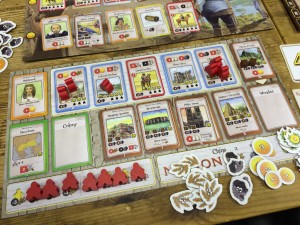
A player’s board showing their card slots.
The first thing that strikes you about Nations is that it’s a civilisation game without a geographic board. Instead, Nations’ more abstracted approach to a civ-themed game delivers a very tight, and different, game for gamers.
Each player has a board showing a limited number of ‘slots’ where cards can be placed. Each slot is colour-coded to show which type(s) of cards (Buildings/Military, Advisor, Colony, and Wonders) can be placed there. There are also two central boards: The progress board (showing the cards available for purchase this round where the row dictates the cost) and the main game board (showing the players’ military strength/stability/total books, plus events, available architects, etc.)
During the game, players take turns to either: Buy 1 card, Deploy 1 worker, or Hire 1 architect to build a wonder. A purchased card must be immediately placed on your player board on a matching coloured slot – building over an existing card if necessary. This adds tension to the game because, not only do you need to figure out which cards will work well with your existing cards, but you need to consider what cards your opponents will be aiming for too. Also, the limited number of slots really makes you think about how to achieve lots with relatively little. (Note that Blue and Red cards share the same slots so more military means fewer buildings and vice versa.) Read the rest of this entry »
Tags: board game news, Board Games, board gaming, Essen, Lautapelit.fi, Nations, Spiel 13, Spiel 2013
Posted in Board Game Review, Board Games, Essen Spiel 13, Nations, Spiel 2013 | No Comments »
Posted by James (admin) on 28th August 2014
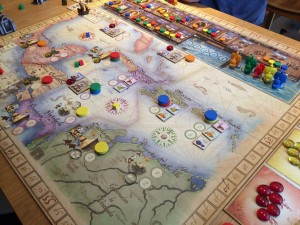 Francis Drake was one of my favourite games at Spiel 2013. A game of sailing, looting and plundering, but with strong eurogame mechanics and some psychological interplay between the players.
Francis Drake was one of my favourite games at Spiel 2013. A game of sailing, looting and plundering, but with strong eurogame mechanics and some psychological interplay between the players.
During the game, players will set sail 3 times and each voyage consists of a provisioning phase and a sailing phase. The provisioning phase is where the players gather resources for their journey: guns, crew, supplies, trade goods, a bigger ship, special roles, etc. Players take turns moving along the main street of Plymouth – 18 locations laid out in a long line – and the players take turns using a location by placing one of their 10 action discs to gain whatever the location offers. However, players can only select locations further down the street from their last location (and never go backwards). Also, some locations have limited slots/uses, plus some of the actions on a location are better than others. As a result, players want to progress slowly to use lots of different locations, but move quickly so they can grab what is on offer before someone else does (and they are potentially left without a resource they want). If you’ve played Egizia (one of my favourite games), you’ll recognise this very engaging game mechanic. Read the rest of this entry »
Tags: board game news, Board Games, board gaming, Eagle Games, Essen, Francis Drake, Spiel 13, Spiel 2013
Posted in Board Game Review, Board Games, Essen Spiel 13, Francis Drake, Spiel 2013 | No Comments »
Posted by James (admin) on 16th July 2014
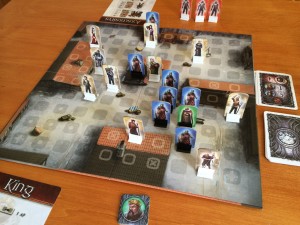 King and Assassins is an asymmetric, 2-player game where the King player controls the king and his knights; whereas, the Assassin player controls the villagers in the town of which 3 are assassins who are trying to kill the king.
King and Assassins is an asymmetric, 2-player game where the King player controls the king and his knights; whereas, the Assassin player controls the villagers in the town of which 3 are assassins who are trying to kill the king.
The rules are simple. Each player has a number of action points (APs) to spend on their turn which can be used to move their figures, make attacks, etc. Each turn, a card is drawn which determines how many APs the King player can spend (there are separate amounts for the king and to be spent amongst the knights), plus it shows if a knight can arrest 1 villager that turn (permanently removing it). Also, each card shows how many APs the Assassin player can spend on their villagers/assassins too. If the cards run out or the king is killed (wounded twice) before reaching the castle, the Assassin player wins. Read the rest of this entry »
Tags: board game news, Board Games, board gaming, Essen, King and Assassins, Spiel 13, Spiel 2013
Posted in Board Game Review, Board Games, Essen Spiel 13, King and Assassins, Spiel 2013 | No Comments »
Posted by James (admin) on 12th June 2014
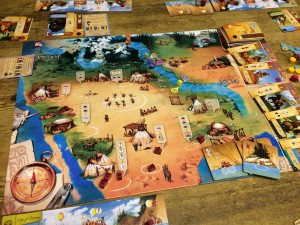 Lewis & Clark is a game about the famous explorers’ journey across North America and the players race along the route from St Louis to Fort Clatsop (on the Pacific coast) which is a sequence of river and mountain spaces. The winner is the first player to make camp at Fort Clatsop.
Lewis & Clark is a game about the famous explorers’ journey across North America and the players race along the route from St Louis to Fort Clatsop (on the Pacific coast) which is a sequence of river and mountain spaces. The winner is the first player to make camp at Fort Clatsop.
Players have characters (cards) and Indians (meeple) which they use to take actions which earn resources and, ultimately, advance their scout. Each player starts with a board showing several boats (and they can gain more) which is where they store their resources and Indians. The boats limit how much a player can carry but they have another important role/effect too when it comes to making camp.
Making Camp
On their turn, a player can ‘make camp’ which moves their camp marker to where their scout is, plus they pick-up all their played cards back into their hand. However, before placing the camp marker, the scout must first move backwards a number of spaces based on how many unplayed cards the player has, plus the resources/Indians in their boats. Each boat specifically carries resources or Indians – some carry items without penalty, some have a flat rate cost regardless of contents, and some have a penalty for every item in the boat. Read the rest of this entry »
Tags: board game news, Board Games, board gaming, Essen, Lewis & Clark, Lewis and Clark, Ludonaute, Spiel 13, Spiel 2013
Posted in Board Game Review, Board Games, Essen Spiel 13, Lewis and Clark, Spiel 2013 | 6 Comments »
Posted by James (admin) on 2nd June 2014
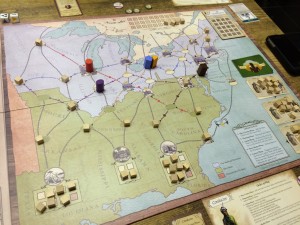
Freedom: The Underground Railroad is a co-operative game of freeing slaves in 19th Century America. The board shows the Eastern United States with routes between cities. Slaves (represented by cubes) start in the 3 plantation areas in the South and players try to move them across the States to freedom in Canada. There are also 5 different coloured/shaped slave catchers on the board who move along their own paths (primarily running East-West) throughout the game.
The goal is to get enough slaves to Canada before the game ends after a fixed number of rounds; however, players can only win if they also get enough support for the abolitionist movement (by buying every support counter), plus the game immediately ends in failure if too many slaves are lost. The numbers of freed slaves required, support tokens, tokens that move slaves and generate income, and maximum lost slaves are all based on the number of players and the difficulty level (normal or hard). Read the rest of this entry »
Tags: Academy Games, board game news, Board Games, board gaming, Freedom, Spiel 13, Spiel 2013
Posted in Board Game Review, Board Games, Essen Spiel 13, Freedom, Spiel 2013 | No Comments »
Posted by James (admin) on 1st June 2014
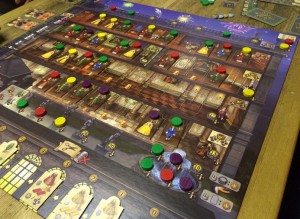 Rokoko is a euro-game about preparing for the ball at the Royal Palace. This may sound pretty light-weight but, do not be fooled, this is a euro-game with a lot of moving parts to work out, balance and combine – so it’s a game for gamers. It’s one of the games nominated for Spiel des Jahres Kennerspiel 2014 (the German complex game of the year).
Rokoko is a euro-game about preparing for the ball at the Royal Palace. This may sound pretty light-weight but, do not be fooled, this is a euro-game with a lot of moving parts to work out, balance and combine – so it’s a game for gamers. It’s one of the games nominated for Spiel des Jahres Kennerspiel 2014 (the German complex game of the year).
Players are aiming to earn the most Prestige Points (PPs) by the end of the game which is 7 rounds long when the ball takes place. Players each have cards which represent their tailors and, at the start of each round, players select 3 of their available tailors to use during that round. Players then take turns using one tailor to perform 1 action and they can also carry out any bonus shown on the tailor’s card too. Tailors are either apprentices, journeymen, or masters and some actions can not be performed by the less experienced tailors, i.e. only journeymen and masters can make dresses, and only masters can hire new tailors. Read the rest of this entry »
Tags: board game news, Board Games, board gaming, Eggertspiele, Essen, Pegasus Spiele, Rococo, Rokoko, SdJ, Spiel 13, Spiel 2013, Spiel des Jahres
Posted in Board Game Review, Board Games, Essen Spiel 13, Rokoko, Spiel 2013 | No Comments »
Posted by James (admin) on 23rd May 2014
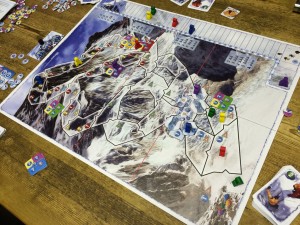 Mount Everest is a game by the designer of K2 which is a great game and you can read my review of K2 for more details. (This review assumes you have not played K2 and I will talk about comparisons at the very end.)
Mount Everest is a game by the designer of K2 which is a great game and you can read my review of K2 for more details. (This review assumes you have not played K2 and I will talk about comparisons at the very end.)
Players each have 2 guides who can escort clients (climbers and tourists) up and down the mountain. Players score Victory Points (VPs) for getting clients to the summit, and more VPs for getting those clients who have reached the summit safely back to base camp. Tourists are worth more VPs but are less hardy than climbers. Your guides can carry tents and oxygen too which are both very useful (in fact, they’re almost vital).
Each guide has a small board showing what they have with them (equipment and clients) but there is very limited space; for example, a guide can take 4 clients and no equipment, or 1 tent and 1 client, or 1 oxygen and 2 clients, etc. So, right from the start, you need to have a strategy on what to take and how to split it between your guides. Read the rest of this entry »
Tags: board game news, Board Games, board gaming, Essen, K2, Mount Everest, Rebel.pl, Spiel 13, Spiel 2013
Posted in Board Game Review, Board Games, Essen Spiel 13, Mount Everest, Spiel 2013 | No Comments »
Posted by James (admin) on 17th April 2014
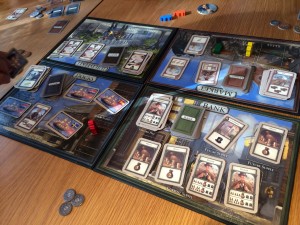 One of my favourite board games ever is Oregon (which was the game the designers of Rattus made before Rattus). So, after many Rattus expansions, I was very excited when the Bergs announced a new, original game called Packet Row with a very interesting game mechanic.
One of my favourite board games ever is Oregon (which was the game the designers of Rattus made before Rattus). So, after many Rattus expansions, I was very excited when the Bergs announced a new, original game called Packet Row with a very interesting game mechanic.
The game is set in New York in 1842 and players are trading companies. The game board is comprised of 4 boards (Docks, Bank, Market and Guildhall) where the cards for each board are displayed. The primary method of earning money is by completing contracts (Guildhall cards) which can be fulfilled by having the goods (Market cards) and ship (Dock cards) shown on the contract. Money can also be gained from the bank (Bank cards), plus various other cards in all areas have some special effects too including some being worth victory points (VPs). At the end of the game, players add up their VPs from cards that show VPs, cash (divided by 10), and banker cards (if they have the most cash) – most VPs wins. This means cash is vital because most cards cost money, and cards can earn you more money, VPs and special abilities.
Gameplay is simple and fast as each player may gain up to 1 card during a round. So far this is all straight forwards but it is how the cards are gained that is the interesting heart of Packet Row. Each round, one player is the lead player (the harbour master) and they select one of the 4 boards. All players then take turns choosing to either take one of the cards from this board or pass. The harbour master is the last player to choose – if the harbor master takes a card then the round ends and any player(s) who passed get nothing. If the harbour master doesn’t take a card, then the harbour master chooses another board and all players who have not yet taken a card this round have the same choice again – take a card from this board or pass. Read the rest of this entry »
Tags: board game news, Board Games, board gaming, Essen, Oregon, Packet Row, Rattus, Spiel 13, Spiel 2013, White Goblin Games
Posted in Board Game Review, Board Games, Essen Spiel 13, Packet Row, Spiel 2013 | No Comments »
Posted by James (admin) on 16th April 2014
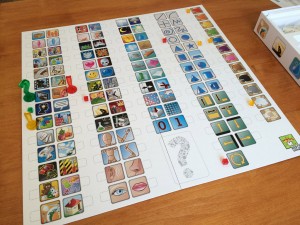
My attempt at ‘Wheel of Fortune’ using TV show with ideas as the main concept. Then, adding a sub-concept of Title with circle, rotate & cash. Then, adding a sub-concept of Country with Red, White, Blue & Star. Anyone? Anyone? Bueller?
Concept is a party game that is a bit like charades without the acting and players use a board with icons to convey the various concepts so the other players can guess the correct answer. Each turn, the players whose turn it is draw a card and choose which word/expression they will try to convey by placing coloured markers on the different descriptive icons on the board. Player aid sheets show all the icons with 2 or 3 things that each icon could mean (although players can use them to mean anything they want). Icons show things like colours, shapes, parts of the body, etc. and some have broader potential meaning like a figure with a walking stick can mean Old/Ancient/Past.
To convey a word/phrase, the current players place various markers on these icons. There is one green question mark marker with green cubes (which is used to describe the main concept) and 4 different colour exclamation mark markers with matching coloured cubes (which can be used to describe additional sub-concepts).
For example, to convey ‘Eiffel Tower’ a player could place the green question mark on ‘Object/Thing/Package’ and a green cube on ‘Tall/Greater/High’ to try to convey the main concept is a tall object. Then, they place a red exclamation mark on ‘Location/Country/Flag’ and red cubes on ‘Red’, ‘White’, and ‘Blue’ to convey the sub-concept is a country with a red, white and blue flag. Already the description is taking shape, although players may guess it’s The Shard in London, or the World Trade Centre in New York from the same markers. Read the rest of this entry »
Tags: board game news, Board Games, board gaming, Concept, Essen, Repos Productions, Spiel 13, Spiel 2013
Posted in Board Game Review, Board Games, Concept, Essen Spiel 13, Spiel 2013 | No Comments »
Posted by James (admin) on 15th April 2014
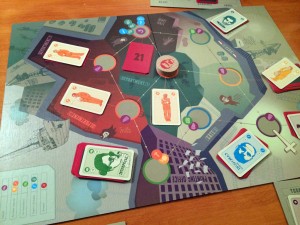 Strike is a game about Lech Wałęsa – a Polish electrician who became a trade-union activist, co-founded Solidarity (the Soviet bloc’s first independent trade union) and eventually went on to become President of Poland. The game focuses on the Polish strikes of 1980 and the agreement reached between the workers and the government. (Yes, really.)
Strike is a game about Lech Wałęsa – a Polish electrician who became a trade-union activist, co-founded Solidarity (the Soviet bloc’s first independent trade union) and eventually went on to become President of Poland. The game focuses on the Polish strikes of 1980 and the agreement reached between the workers and the government. (Yes, really.)
This theme may sound unusual even compared to some other board games, but the historical Polish theme is more understandable when you know the game is by Karol Madaj the designer of Kolejka (Queue) – one of my favourite games ever – who designs games for Poland’s Institute of National Remembrance. One of their goals is to mark important moments in Polish history.
Theme-aside, Strajk is fundamentally a deck-building game mechanic but with a board and a bit if a difference too. (If you’re not familiar with deck-building games such as Dominion, players each have their own deck and play cards to add better cards to their deck, take special actions, remove weaker cards from their deck, etc. Whenever their deck is empty, they shuffle their discard pile and start drawing from it again so their deck builds as they play.) Read the rest of this entry »
Tags: board game news, Board Games, board gaming, Essen, Kolejka, Queue, Reglamentacja, Spiel 13, Spiel 2013, Strajk, Strike
Posted in Board Game Review, Board Games, Essen Spiel 13, Kolejka (Queue), Reglamentacja, Spiel 2013, Strajk (Strike) | No Comments »





 Lewis & Clark is a game about the famous explorers’ journey across North America and the players race along the route from St Louis to Fort Clatsop (on the Pacific coast) which is a sequence of river and mountain spaces. The winner is the first player to make camp at Fort Clatsop.
Lewis & Clark is a game about the famous explorers’ journey across North America and the players race along the route from St Louis to Fort Clatsop (on the Pacific coast) which is a sequence of river and mountain spaces. The winner is the first player to make camp at Fort Clatsop.
 Rokoko is a euro-game about preparing for the ball at the Royal Palace. This may sound pretty light-weight but, do not be fooled, this is a euro-game with a lot of moving parts to work out, balance and combine – so it’s a game for gamers. It’s one of the games nominated for
Rokoko is a euro-game about preparing for the ball at the Royal Palace. This may sound pretty light-weight but, do not be fooled, this is a euro-game with a lot of moving parts to work out, balance and combine – so it’s a game for gamers. It’s one of the games nominated for 


 Strike is a game about Lech Wałęsa – a Polish electrician who became a trade-union activist, co-founded Solidarity (the Soviet bloc’s first independent trade union) and eventually went on to become President of Poland. The game focuses on the Polish strikes of 1980 and the agreement reached between the workers and the government. (Yes, really.)
Strike is a game about Lech Wałęsa – a Polish electrician who became a trade-union activist, co-founded Solidarity (the Soviet bloc’s first independent trade union) and eventually went on to become President of Poland. The game focuses on the Polish strikes of 1980 and the agreement reached between the workers and the government. (Yes, really.)